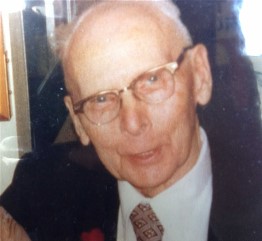|
Jul 28, 1897
|
Born in Perth, Ontario to Richard and Emma (nee
Publow) Leighton.
His father Richard, died December 23, 1896, prior
to his birth. His mother Emma, died in
March of 1904
|
|
Nov 7, 1914
|
Attested into the 21st Battalion in Kingston, Ontario
Ø Number 59581 (temporary number 947)
Ø Next of kin given as Mrs. James McGarvey, sister, Saskatoon,
Saskatchewan
o Note to also notify Mrs. Robert Publow, aunt, Perth, Ontario
Ø Previous occupation given as Telegraph Operator
o Later noted as Railroad Telegraph Operator for Canadian Pacific
Railway
Ø No previous military experience given
Ø Religion given as Presbyterian
Ø Posted to “D” Company
o Later posted to the Signals Section of the Headquarters Company
Richard Leighton lied about his age, stating he was born July
28, 1896, not his actual birth date of July 28, 1897
The 21st Battalion trained in the Kingston, Ontario
area through the winter of 1914-15.
|
|
May 6, 1915
|
Embarked the RMS Metagama in Montreal, Quebec

|
|
May 15, 1915
|
Disembarked in Devonport, England and the
battalion proceeded to the West Sandling Camp, near Hythe, Kent to continue
training
|
|
Jul 9, 1915
|
Admitted to the Moore Barracks Hospital in
Shorncliffe with a diagnosis that reads Varicocele, an enlargement of veins
in the scrotum
|
|
Jul 12, 1915
|
Transferred to the RAMC (Royal Army Medical
Corps) hospital in Shorncliffe
|
|
Jul 31, 1915
|
Transferred to the Wakeley House VAD (Volunteer
Aid Detachment) Hospital in Shorncliffe
|
|
Aug 20, 1915
|
Discharged to duty from hospital
|
|
Sep 14, 1915
|
Embarked the St. Seiriol in Folkestone
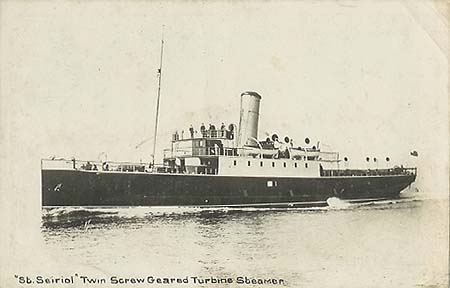
|
|
Sep 15, 1915
|
Disembarked in Boulogne, France and the battalion
proceeded to St. Omer
|
|
Feb 24, 1916
|
Admitted to the No. 5 CFA (Canadian Field
Ambulance) with a diagnosis that reads Hydrocele, an inflammation in the
scrotum
|
|
Feb 29, 1916
|
Discharged to duty from the field ambulance
|
|
Nov 3, 1916
|
Granted 10 days leave
|
|
Nov 7, 1916
|
Awarded the Good Conduct Badge
|
|
Nov 18, 1916
|
Rejoined the battalion from leave
|
|
Nov 24, 1916
|
Appointed to the rank of Lance Corporal
|
|
Apr 25, 1917
|
During an attack on German lines south of
Acheville, France, Lance Corporal Leighton received multiple shrapnel wounds
to his face, hands, legs and hips while handling communications at “C”
Company Headquarters. He was first
evacuated to a field ambulance for first aid before being transported to a
casualty clearing station.
|
|
Apr 26, 1917
|
Surgery performed to remove shrapnel from his
legs and buttocks
|
|
Apr 30, 1917
|
Transferred to the 3rd General
Hospital in Boulogne
|
|
May 2, 1917
|
Invalided to England aboard the Hospital Ship
Pieter de Coninck
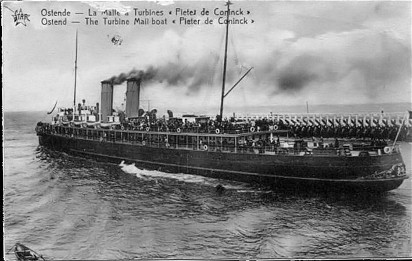
On arrival in England, he was admitted to the War
Hospital in Keighley, Yorkshire. On
admission the wounds are noted as “smell badly”.
Transferred to the EORD (Eastern Ontario
Regimental Depot) for pay purposes while in hospital
|
|
Jun 16, 1917
|
Transferred to the CCH (Canadian Convalescent
Hospital), Monks Horton
|
|
Jun 26, 1917
|
X-ray shows several shrapnel fragments in his
left hand
|
|
Aug 2, 1917
|
Transferred to the Moore Barracks Hospital in
Shorncliffe
|
|
Aug 7, 1917
|
Surgery performed to amputate ring finger of his
left hand and remove damaged bone fragments
|
|
Aug 28, 1917
|
Transferred to the Military Convalescent Hospital
in Epsom
|
|
Oct 2, 1917
|
Transferred to the Canadian Military Hospital in
Kirkdale
|
|
Nov 15, 1917
|
Invalided to Canada aboard the Hospital Ship
Glenart Castle
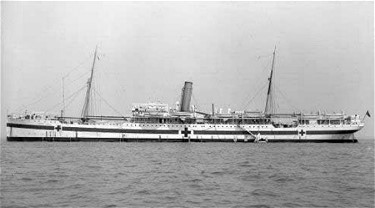
|
|
Nov 26, 1917
|
Disembarked in Saint John, New Brunswick and
proceeded to Kingston, Ontario
On arrival in Kingston, he was admitted to the
Kingston Convalescent Home
|
|
Dec 3, 1917
|
Transferred to the Queen’s University Hospital in
Kingston to be treated as an out-patient
|
|
Mar 26, 1918
|
Medical Board at Queen’s University Hospital in
Kingston notes
Ø Suffered shrapnel wounds to
his face, right thigh and buttock, left hand and left thigh]
Ø Unable to flex right leg and
cannot walk properly
Ø All his scars are sensitive to
the touch
Ø Ring finger of left hand
amputated and has poor function of hand
Ø Facial scars from shrapnel
wounds bleed easily when shaving
Ø There is a shrapnel fragment
embedded in the skin below his right eye
Ø Disability is determined to be
60%
Ø Board recommends he be
discharged from service as medically unfit
|
|
Apr 8, 1918
|
Discharged from the CEF in Kingston, Ontario
Ø Rank on discharge Lance
Corporal
Ø Entitled to War Service Badge
Class “A”
Ø Proposed residence on
discharge Perth, Ontario
Following the end of the war, the 1914-15 Star,
British War Medal and Victory Medals were sent to him at Perth, Ontario
|
|
Oct 30, 1920
|
Married to Gertrude Mary Flett in Melfort,
Saskatchewan
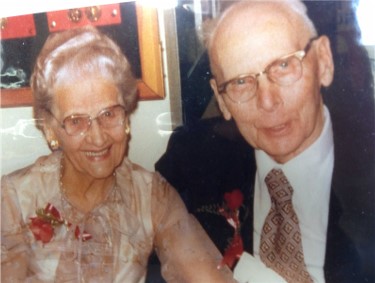
|
|
Feb 7, 1979
|
Richard Leighton died in the Memorial Pavilion,
Victoria, British Columbia of Hypostatic Pneumonia that was complicated by
Epilepsy and Brain Disease. He had
suffered from Kidney failure for many years.
Following an autopsy, Richard Leighton’s remains
were cremated and returned to his family
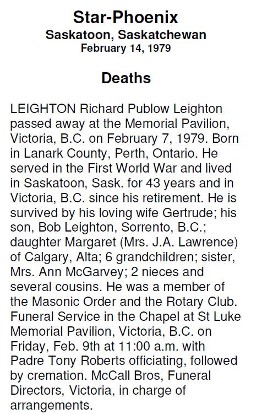
|
|
